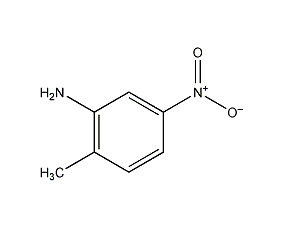
Structural formula
| Business number | 02FZ |
|---|---|
| Molecular formula | C7H8N2O2 |
| Molecular weight | 152.15 |
| label |
5-nitro-o-toluidine, big red bass, flag red bass, Big red base G, 5-Nitro-o-toluidine, 2-Amino-4-nitrotoluene, 5-Nitro-2-methylaniline, Ch3c6h3(no2)nh2, dye |
Numbering system
CAS number:99-55-8
MDL number:MFCD00007741
EINECS number:202-765-8
RTECS number:XU8225000
BRN number:879021
PubChem number:24897058
Physical property data
1. Character: golden yellow crystal
2. Density (g/mL, 20℃): Undetermined
3. Relative vapor density (g/mL, air = 1): Undetermined
4. Melting point (ºC): 107
5. Boiling point (ºC, normal pressure): Undetermined
6. Boiling point ( ºC, kPa): Not determined
7. Refractive index: Not determined
8. Flash point (ºC): Not determined
9. Specific rotation (º): Not determined
10. Autoignition point or ignition temperature (ºC): Not determined
11. Vapor pressure (mmHg, 20.2ºC): Not determined
12. Saturated vapor pressure (kPa, ºC): Undetermined
13. Heat of combustion (KJ/mol): Undetermined
14. Critical temperature (ºC) : Undetermined
15. Critical pressure (KPa): Undetermined
16. Log value of oil-water (octanol/water) partition coefficient: Undetermined
17. Explosion upper limit (%, V/V): Undetermined
18. Explosion lower limit (%, V/V): Undetermined
19. Solubility: Slightly soluble Insoluble in cold water, insoluble in hot water, soluble in ethanol, ether, benzene and acetone.
Toxicological data
1. Chronic toxicity/carcinogenicity: Mouse oral TDLo: 150mg/kg/78W-C; 2. Mutagenicity: Mutant microorganism test: bacterium – Salmonella typhimurium, 10μg/plate; Salmonella, 33300μg/plate; Morphological conversion test: rat embryo, 41μg/plate; Morphological conversion test: mouse embryo, 160μg/L;
Ecological data
It is extremely harmful to water and toxic to fish.��, never let the product enter the water body.
Molecular structure data
1. Molar refractive index: 41.85
2. Molar volume (cm3/mol): 119.8
3. Isotonic specific volume (90.2K ): 326.2
4. Surface tension (dyne/cm): 54.9
5. Dielectric constant:
6. Dipole moment (10-24cm3):
7. Polarizability: 16.59
Compute chemical data
1. Reference value for hydrophobic parameter calculation (XlogP): None
2. Number of hydrogen bond donors: 1
3. Number of hydrogen bond acceptors: 3
4. Number of rotatable chemical bonds: 0
5. Number of tautomers: none
6. Topological molecule polar surface area 71.8
7. Number of heavy atoms: 11
8. Surface charge: 0
9. Complexity: 155
10. Number of isotope atoms: 0
11. Determine the number of atomic stereocenters: 0
12. Uncertain number of atomic stereocenters: 0
13. Determine the number of chemical bond stereocenters: 0
14. Number of uncertain chemical bond stereocenters: 0
15. Number of covalent bond units: 1
Properties and stability
Avoid contact with strong oxidizing agents.
Storage method
Store in a cool, ventilated warehouse. Keep away from fire and heat sources. should be kept away from oxidizer, do not store together. Equipped with the appropriate variety and quantity of fire equipment. Suitable materials should be available in the storage area to contain spills.
Synthesis method
Using o-toluidine as raw material, it is obtained through salt formation, nitrification, water precipitation, dissolution and decolorization, neutralization and dehydration and drying. Cool the nitric acid with a relative density of 1.4 to below 20°C, add dry powdered o-methylacetanilide with stirring, control the temperature below 70°C, and cool to obtain a yellow solid. Add sulfuric acid and reflux. After 2 hours, cool and filter out the insoluble matter. Neutralize with 40% sodium hydroxide below 40°C to pH=1-2 to obtain yellow crystals. Filter, wash with water, and recrystallize with ethanol to obtain 5-nitro-o-toluidine. Raw material consumption quota: o-toluidine 876kg/t, sulfuric acid (100%) 4350kg/t, nitric acid (98%) 520kg/t, soda ash (98%) 1700kg/t, activated carbon 1kg/t.
Purpose
Dye intermediates. As a color base for ice dyeing, it is used for dyeing and printing cotton fabrics, and can also be used for dyeing silk, viscose and nylon fabrics. It can also be used as an intermediate for organic pigments and dyes, such as the production of disperse yellow S-3GL, paint red, solid red G, permanent red F4R, 3149 permanent red F4RT, solid deep red, etc.

 微信扫一扫打赏
微信扫一扫打赏

